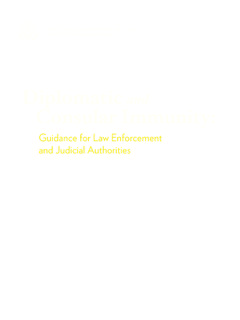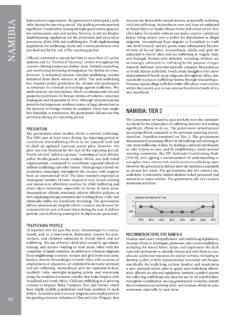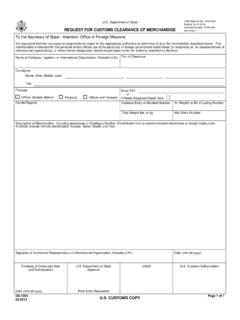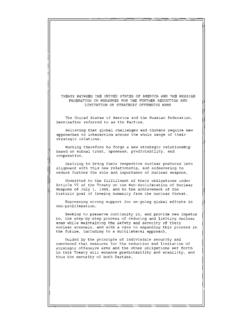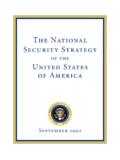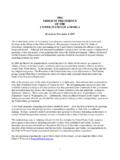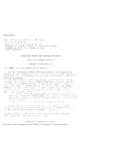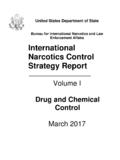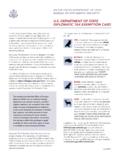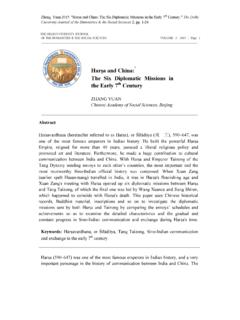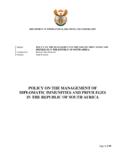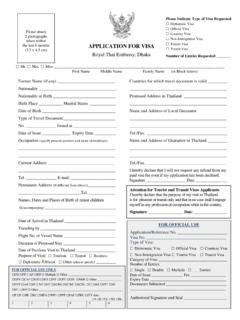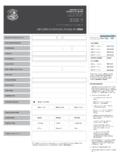Transcription of Mission Statement - U.S. Department of State
1 I Mission Statement The Foreign Service Institute develops the men and women our nation requires to fulfill our leadership role in world affairs and to defend interests. About FSI Established in 1947, the Foreign Service Institute is the United states Government s primary training institution for employees of the foreign affairs community, preparing American diplomats and other professionals to advance foreign affairs interests overseas and in Washington. FSI provides more than 600 courses to include training in some 70 foreign languages, as well as in leadership, management, professional tradecraft, area studies, and applied information technology skills to some 100,000 students a year, drawn from the Department of State and more than 40 other government agencies and military service branches.
2 FSI provides support to all Government employees involved in foreign affairs, from State Department entry-level specialists and generalists to newly-assigned Ambassadors, and to our Foreign Service National colleagues who assist efforts at some 270 posts Table of Contents Introduction .. 1 Protocol In Brief .. 2 International Culture .. 2 Addressing Others .. 2 Introductions .. 3 Titles .. 4 Mission 6 Before Arrival .. 6 Arriving at Post .. 6 Welcoming .. 6 Making Calls .. 7 Business Cards .. 8 Responsibilities at Post .. 9 10 Host Country Culture .. 12 Social Red Flags .. 12 Being a Guest .. 14 Resources for Understanding Host Culture.
3 15 Entertaining .. 15 Whom to Invite .. 16 Informal Entertaining .. 17 Formal Entertaining .. 17 Dress .. 24 Formal "Black Tie" or "White Tie" .. 24 Semi-formal/Informal .. 25 Casual .. 25 Medals and Decorations .. 26 Summary .. 26 Glossary of diplomatic Terms .. 29 Bibliography .. 32 1 Introduction January 2011 Few things are as anxiety provoking for the first-time embassy or Mission employee or family member as the notion of diplomatic protocol. Protocol can sound both stuffy and mysterious at the same time; and most of us believe we have had little experience in our non-government lives to prepare us. In fact, the rules and processes of diplomatic protocol are based in pragmatic thinking, common sense, and good manners areas where we all have had some experience.
4 Protocol makes the job of representing our nation easier by facilitating our work as a Mission team, making our relationships and interactions within the diplomatic and host country communities more predictable, and by providing a basic social framework and hierarchy to follow. We've designed this booklet to help you begin to master the basics of diplomatic protocol. Whether you are an employee or spouse, have few representational responsibilities or are running your post s protocol office, this booklet is a good starting point for you. The booklet's four main sections deal with international culture, Mission culture, the host-country culture, and entertaining.
5 A bibliography and diplomatic glossary are included at the end of the text. Our sincere hope is that you take the time to read through Protocol for the Modern Diplomat, and make a point of adopting and practicing this art and craft during your overseas assignment. We believe doing so will make you more personally effective overseas, and thereby make our missions more effective. Ray S. Leki Director Transition Center 2 Protocol In Brief Protocol is not an end in and of itself. Rather, it is a means by which people of all cultures can relate to each other. It allows them the freedom to concentrate on their contributions to society, both personal and professional.
6 Protocol is, in effect, the frame for the picture rather than the content of it. In the relaxed atmosphere of American society, many of the rules of social behavior that were routine a generation ago are today largely ignored, if not unknown. American casualness is often interpreted as rudeness in other societies. What does it say if the representatives of the world s most powerful nation are indifferent to the appropriate respect owed to representatives of other nations, or to ranking members of their own staff abroad? This can be taken as a personal or national insult. There is rarely an entirely private situation in which one s behavior is not being observed.
7 International Culture At gatherings that include representatives from the host country as well as from other countries, the timeless formality of international diplomatic culture remains in place. It ensures that each country will be respected uniformly and without bias. The necessary respect is expressed most visibly through spoken courtesies. Below are some tips on how to address and introduce diplomatic representatives. Addressing Others Although guidelines exist, proper forms of address vary greatly from culture to culture. Be sure to check local customs, but a few general rules follow. The spirit of formality among diplomatic representatives usually means not addressing others by their first names as quickly as is done in the United states .
8 One should rely on courtesy titles until invited to do otherwise. Socially, one can refer to a spouse by his/her first name or as "my husband" or "my wife" rather than as "Mr. /Mrs. Smith." When dealing with household employees however, you should still refer to your spouse as "Mr. /Mrs. Smith." Ambassadors are addressed as Mr. /Madam Ambassador or Ambassador Jones. Only by special invitation or long friendship should one address an ambassador by first name and then only when not in the public eye. In indirect address, refer to the ambassador as "the ambassador", with his/her spouse as "the ambassador and Mr. /Mrs. Jones," or if the ambassador's spouse is a woman who kept her maiden name after marriage, "the ambassador and his wife, Ms.
9 Smith." An ambassador of the United states may continue to be addressed as "Mr. /Madam Ambassador" after retirement or after returning from his/her duties abroad. In some French-speaking countries, the wife of the ambassador may be referred to as Madam Ambassador. Therefore, in those countries, refer to a female ambassador by her last name (Ambassador Jones) to avoid confusion and ensure that she receives her due respect. 3 Those of rank below Ambassador are addressed as Mr., Ms. or Mrs., if marital status is known. When referring to a post, "the Embassy of the United states of America" is preferred over "the American Embassy." As references to America can be ambiguous, especially in the Western Hemisphere, avoid using terms such as "American ambassador" or "American citizen.
10 " Similarly, to be clear and to avoid offending others by suggesting that the constitutes the entire continent use "United states " in all references to this country. Introductions The purpose of making introductions is to exchange names between people so that a conversation can follow. For a formal occasion, the traditional "Mrs. Smith, may I present Mr. Jones?" is used internationally. For less formal occasions simply stating the two names, "Mrs. Smith, Mr. Jones," is acceptable. Making personal introductions ( , introducing oneself) is perfectly acceptable and encouraged. Adding context about yourself and your role is helpful.
